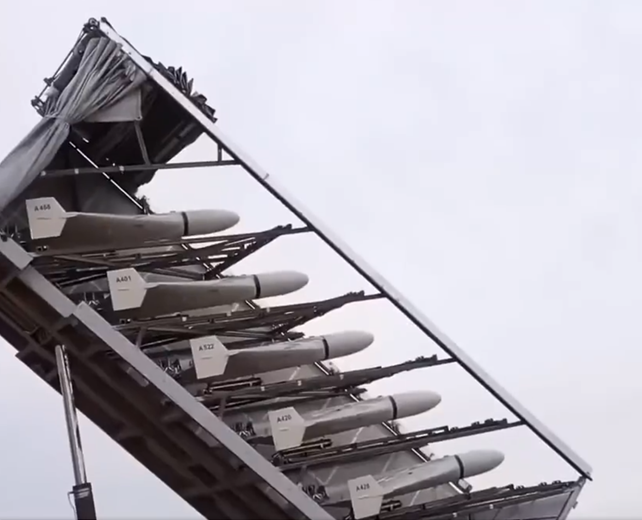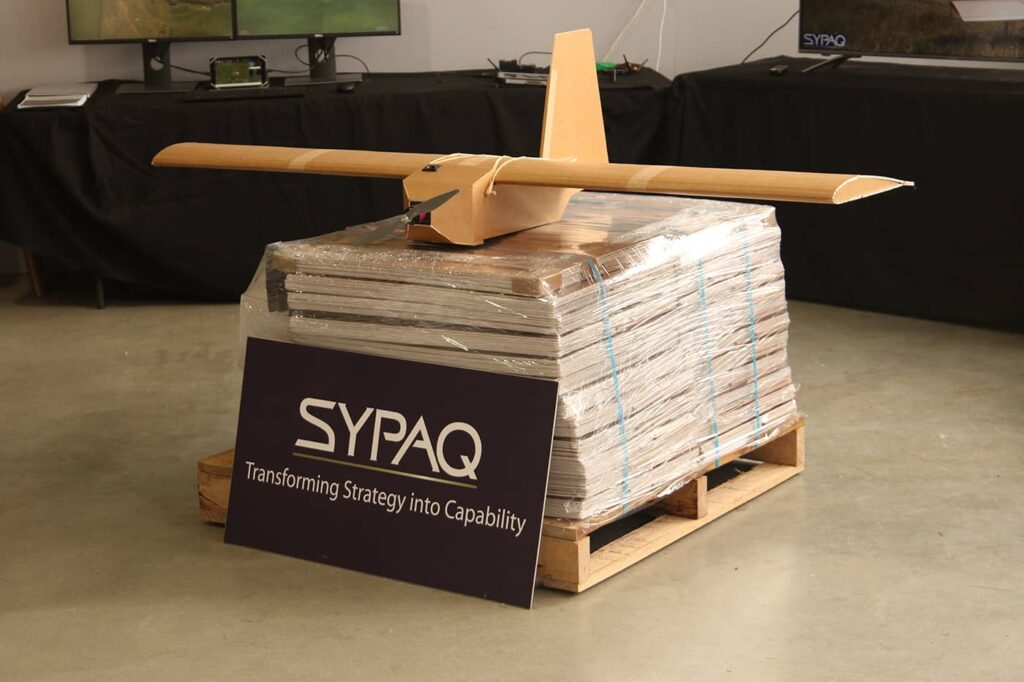Russia’s Iranian-built drones came close to crippling Ukraine’s civilian energy infrastructure as winter was setting in last year, and they are still causing major headaches for Ukraine’s citizens and armed forces. Air defence systems provided by Ukraine’s supporters are proving effective, but they drain personnel and resources that could otherwise be deployed elsewhere in Ukraine’s defence effort. Supplying equivalent drone capabilities to Ukraine would give it a highly cost-effective way to further disrupt and stretch Russian forces.
Russia’s invasion of Ukraine has revealed its shortcomings at every level: strategic, tactical, and operational. Conversely, Ukraine has risen to every challenge with remarkable tenacity and ingenuity.
A prime example of that ingenuity has been the creative fusion of communications technologies and drones, such that drones of many types are now an integral feature of Ukraine’s battlefield operations.
And Russia, too, despite its lengthy catalogue of failings, has shown great resourcefulness in obtaining and using lethal but inexpensive drones from Iran.
Russia’s solutions to missile shortages
The campaign Russia expected to last for days is now into its second year, and Russia’s stocks of surface-to-surface missiles appear to be dwindling, with older missiles being re-purposed from their original roles, such as nuclear delivery, air-defence, and anti-shipping.
However, since the autumn of 2022, Russia has supplemented its strike inventory with so-called “suicide drones”, notably the Iranian-built Shahed-131 and Shahed-136 (given the Russian designations of Geran-1 and Geran-2, respectively).
As weapons systems go, these drones are cheap – estimates suggest between $20,000 and $30,000 – but, with ranges of up to 900 kilometres for the Geran-1 and 1,500 kilometres for the Geran-2, they can threaten targets throughout Ukraine.

Cheap, long-range drones are a “win-win” for the attacker
They have, for instance, proved highly effective in knocking out civilian infrastructure, particularly elements of Ukraine’s power grid, and they now feature regularly as a significant element in Russia’s strikes against Ukraine.
They are difficult to detect and shoot down, and they impose disproportionate costs on Ukraine. Even an inexpensive drone can take out valuable – and costly – resources and assets, compelling Ukraine to divert personnel and defence equipment from tasks elsewhere. And in the last resort, shooting a drone down might require the use of a million-dollar defensive interceptor. (See “Drones and the air defence challenge”).

In other words, even if Ukraine destroys an entire drone swarm, it is still a “win” for Russia; the costs of mounting the attack are far less than the costs of countering it. One analysis, for instance, estimated that Ukraine expended $28 million in anti-air munitions to defend against a series of drone attacks that cost Russia between $350,000 and $800,000. And that takes no account of how Ukraine’s military efforts elsewhere are being blunted by the diversion of resources from other roles and missions.
These suicide drones are therefore a cheap way for President Putin to inflict direct damage on Ukraine, and make Ukraine devote additional resources to air defence. This, in turn, places additional equipment demands – and costs – on Ukraine’s supporters.
One analysis estimated that Ukraine expended $28 million in anti-air munitions to defend against a series of drone attacks that cost Russia between $350,000 and $800,000
In short, these drones have proved to be extremely cost-effective “disruptors”.
And Ukraine does not yet possess directly equivalent strike systems.
Plugging Ukraine’s capability “gap”
The High Mobility Artillery Rocket System (HIMARS) and Multiple Launch Rocket system (MLRS), for instance, are far more powerful and capable, but much more expensive and short-ranged. And the drones and loitering munitions being provided typically have ranges of less than 100km (sometimes far less), and these are being supplied in hundreds, rather than thousands.
In short, nothing on offer currently occupies the same cost-capability “niche” as Shahed-type drones.
As a recent article by RUSI has pointed out, “The Shahed 136’s simplicity, combined with its almost uncanny accuracy, long range and low cost, makes it unique among strategic standoff weapons.”
The same article points out that: the airframe could be built “by a DIY handyman”; the engine is a copy of Western engines built for air enthusiasts, modelmakers, and manufacturers of civilian and military drones; and the avionics are based largely on commercial electronics that are traded freely around the world.
So perhaps Ukraine’s supporters should look at producing equivalent systems.
Injection moulding could do the work of thousands of “DIY handymen”, and the light engineering skills to assembly the various components are widely available; it is just a matter of bringing them together – and avoiding the “gold plating” that inevitably adds costs and delays to defence projects.
Nothing on offer currently occupies the same cost-capability “niche” as Shahed-type drones.
Their manufacture should be more like that of mopeds than military missiles, with the emphasis on “pile them high and sell them cheap”, rather than “high-tech, all-singing and all-dancing”.
Even if Western manufacturers could not quite match the prices reported for Iranian/Russian systems, even at $30,000 each, a thousand drones would cost “only” $30 million. That would buy a great deal of disruption and inconvenience for Russian forces throughout occupied Ukrainian territory.
Drones and the air defence challenge
Cheap, expendable drones present a particular challenge for air defence.
Even though they can be small, light, and slow, their low radar and thermal signatures, make them difficult to detect.
But they cannot be ignored because they can deliver their relatively small, lethal payloads with great precision, provided they can penetrate the gauntlet of air defences.
What goes up…
These defences include missiles, aircraft, and guns, all of which come in many varieties.
At the “top end” of the air-defence missile scale are systems such as the “Patriot” which can engage certain ballistic and cruise missiles up to range of 100 kilometres. At the other end of the scale are “Man-portable air defence systems” (MANPADS or MPADS) such as the “Stinger”.
Aircraft can also shoot them down, but small, slow, low-flying drones are deceptively hard targets for high-performance jets.
Finally, air defences include many different types of gun systems ranging from vehicle-mounted, radar-controlled, rapid-fire guns such as the Soviet-era ZSU-23-2, right down to personnel using small arms.
And some defensive systems are intended specifically to counter drones. These are usually highly portable, and can locate and track drones using different methods including, radar, RF detectors to pick up control signals, optical sensors, and even acoustic devices. These can be coupled with “kill” mechanisms such as low-cost missiles, guns, projectiles deploying nets, and specially designed “anti-drones”.
There are also numerous electronic countermeasure devices that attempt to disrupt a drone’s control and navigation systems.
Unfortunately, the systems best suited to intercept drones operate over short ranges – typically only a few kilometres – so to protect a large area thoroughly could require hundreds of defensive systems. Put another way, although so-called “point defences” can be highly effective, if an attacker decides to mount indiscriminate attacks against a country with Ukraine’s size and population, it is practically impossible to protect the vast number of potential targets.
…must come down
Furthermore, the debris from interceptions over populated areas could cause casualties and physical damage, even if the intended target is saved.
And some air defence missiles are far more substantial than small drones, so the impacts from wreckage could be comparable with those caused by a deliberate missile attack.
The essential point is that cheap, long-range drones are a “win-win” for the attacker. If they are not intercepted, they can inflict great damage, and even if they are intercepted, they compel the defender to invest in expensive, labour-intensive countermeasures, thereby preventing resources being applied elsewhere.
Ukraine’s HIMARS and MLRS have already forced Russia to move supply depots and logistics facilities further from the front, severely limiting the flow of munitions and the ability to concentrate forces. The use of longer-range drones would cause further withdrawals and dispersal and force Russia to build-up its air defences at much greater depth and over a larger area, diverting more personnel and equipment from other tasks.
Furthermore, such drones would deny a sense of security to Russian forces throughout occupied Ukraine, further eroding their morale, potentially a critical vulnerability.
These drones could be used in coordination with other systems, depleting, distracting, and perhaps overwhelming Russian defensive systems, while freeing other strike systems for more specialized missions.
Another plus for Ukraine is that the drones could be launched well away from the “line of contact” by personnel who are unable to perform front-line tasks.
And, of course, if supplying nations have reservations about enabling Ukraine to strike targets in Russian territory, then they could impose suitable caveats on their use.
Beating the opposition at their own game
Russia’s use of inexpensive “suicide drones” has caused enormous damage in Ukraine and has compelled Ukraine to devote substantial additional resources to air defence.
There is no technical or financial reason why Ukraine’s supporters could not develop an equivalent system (or systems) that could be manufactured quickly at a sustainable cost, assuming production lines could churn out a thousand a month. But why not try for more?
No doubt Ukraine could come up with any number of creative ideas for their employment.
Ukraine’s own experience from the “receiving end” shows just how disruptive such systems can be. And it bears repeating that defending against drone attacks is far more costly and burdensome than mounting the attacks.
Thinking out of the box…

Shipped as “flatpacks”, the Australian Sypaq “Corvo” Precision Payload Delivery System (PPDS) is a light, cardboard drone with a range of about 120 kilometres and can deliver small payloads with a high degree of autonomy. The different variants are reported to cost between $680 to $3,400.
Originally intended to deliver light, high-value supplies to difficult locations, they are also used for intelligence gathering and reconnaissance. Although only designed for a single sortie, many are proving serviceable for several. There have also been reports that some have been adapted for kinetic missions.
The sums involved in mass producing inexpensive drones might not appeal to contractors accustomed to competing for defence programmes costing billions, but many light engineering SMEs might leap at the opportunity. Indeed, some already have come up with some novel, inexpensive systems that, while not filling the Shahed-type niche, show what can be achieved on a remarkably limited budget. (See “Thinking out of the box”).
“Appropriate tech” is as important as “high tech”, and there should be no room for “not invented here” syndrome. Adapting systems developed elsewhere and even reverse engineering is not a failing, but a means to beat the opposition at their own game.

